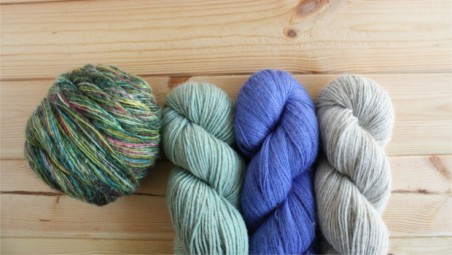What's the deal with natural fibers? We talked to blogger Ashlee Lackovic about why natural fibers are important to the craft community and the planet.
Why are natural fibers important?
With so many choices of yarn out there, it can become very difficult to choose the perfect wool for your project. Not all fibers and yarn are created equal and there is a big debate among knitters, crocheters and all fiber artists about which yarn is the best; especially, when it comes to natural vs. synthetic fibers.
I personally always felt knitting with something like merino wool or linen was a luxury but, now I feel like it is BEST part of knitting. There’s nothing like the feeling of running alpaca yarn through your fingers or creating a shawl with linen/cotton blend.
Although the fiber used, the price point and the brands of yarn all vary greatly, it doesn’t have to be confusing.
Synthetic yarn is man-made. The most common of theses being acrylic which is made from polyacrylonitrile (aka plastic). Although synthetics are readily available, cheap and made in a variety of colors, natural fibers, are just that, natural. You can break down natural fibers into two categories, animal and plant fibers.

Animal fibers
Animal fibers are wool that obviously, comes from animals. The most common and recognizable of the natural fiber yarns is sheep’s wool but, you are not limited to just traditional yarns; everything from Alpaca. angora, cashmere, merino, mohair, silk and even yak wool can be found.
Plant fibers
If you would rather stay away from animal fibers, fear not! You have just as amazing of choices. Bamboo, cotton, hemp, and soy. These yarns are often great for knitting all year around, durable and surprisingly fun to create with! Many of them can be used by people who are allergic or cannot tolerate animal fibers.There really is something for everyone and the beautiful creations you can make from these yarns is truly endless.

What can natural fibers do that synthetic ones can't?
Natural yarns tend to keep in warmth better and are more durable than synthetic yarn. Felting it can only be really done with animal fibers. Blocking for example is difficult, if not impossible, with acrylic yarn. However, with natural yarns you can easily create the final shape and fit you require for your garment or project when you use natural fiber yarn.
In terms of environmental impact. Natural fibers are a sustainable resource. Sheep, alpacas, and mountain goats will continue grow their fleece. Hemp, cotton, and bamboo are all naturally occurring plants and are excellent choices for knitters and crocheters who want to choose eco-friendly products.
We are all becoming more aware on how our everyday choices affect our environment and choosing natural fiber yarns is a great way to begin reducing our impact on our planet! Don’t be afraid to try a new yarn or new type of fiber from what you would normally choose. You may be pleasantly surprised on how amazing your project looks, and feels!
To check out Laughing Hens extensive natural fiber yarn lines please check out the yarns & wools section of our website. Patterns to accompany these amazing yarns can be found here.


Ashlee Lackovic is a blogger and pattern designer from the snowy mountains of British Columbia, Canada. She runs her own knitting website called Smashlee Stitches where she shares her love of all things knitting with the world. Click here to visit her Smashlee Stitches blog, and follow her on Facebook, on Instagram, and on Twitter. Photography credit: Joy Segovia



